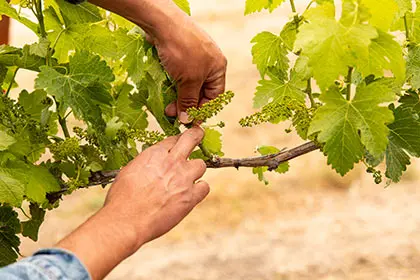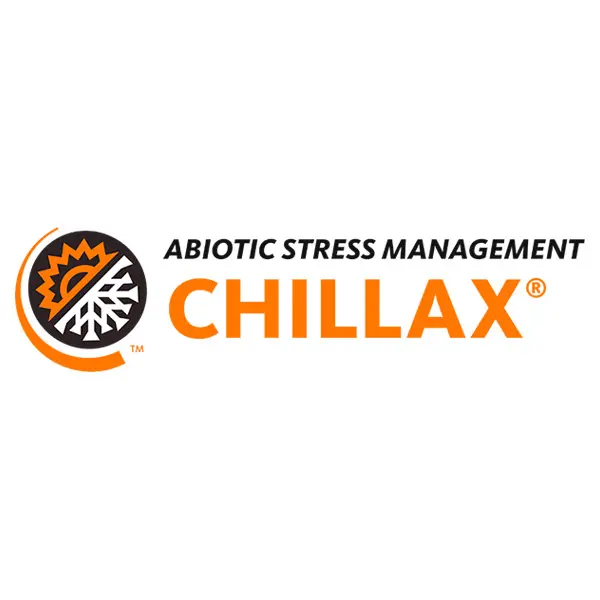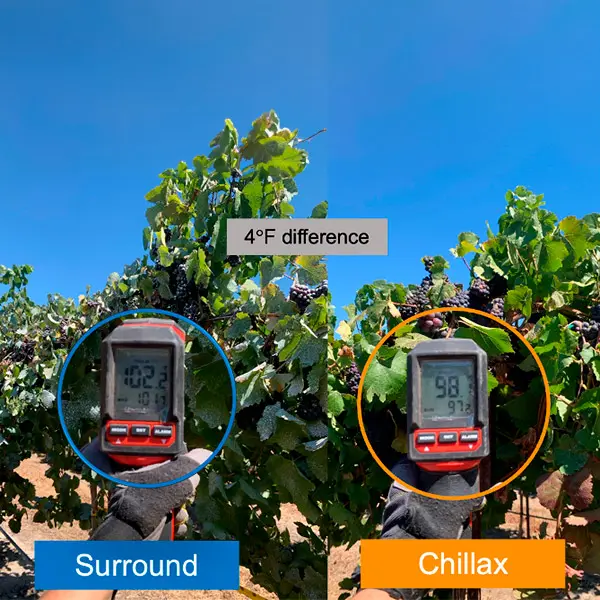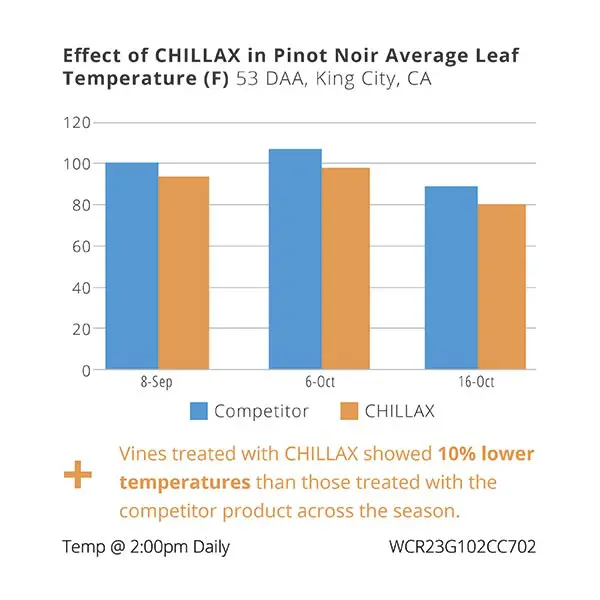
Help grapes beat the heat
Help grapes beat the heat
CHILLAX® protects vineyards and limits the negative effects of extreme heat events.
Heat stress poses a significant risk for grapes, reducing yield, fruit quality and marketability of the crop. Compounding the challenge, the frequency and intensity of extreme heat events have been on the rise in recent years. From 1950 to 2021, the magnitude of extreme heat events increased by at least 1.76 degrees Fahrenheit (°F) per decade during the day at 10 of 14 California weather stations1. Recent agronomic trials with CHILLAX®, a flowable micronized calcium carbonate foliar product, have shown encouraging results in mitigating the effects of heat stress.
Heat effects
Kaan Kurtural, Ph.D., senior agronomy technology information manager at Wilbur-Ellis, has been evaluating solutions to protect heat-sensitive crops. Multiple such studies near Davis and Santa Barbara, California were designed evaluate the effects of CHILLAX in supporting grapes during extreme heat events.
“Grapes are particularly sensitive to heat. Heat stress can lead to raisining, reducing yield by up to 27% per acre if the fruit is unprotected,” says Kurtural. “When this happens, the fruit itself becomes black as tissue death occurs.”
Additionally, heat stress can reduce sugar per fruit. As the vine burns sugars, it also burns organic acids. The result is dehydrated grapes with very little sugar, as well as less-than-ideal organic acids in the tissue, lowering winemaking quality.
“With CHILLAX, we’re making sure we’re farming the correct components for the winemaker rather than just yield,” says Kurtural. “We’re preserving secondary plant compounds, such as tannins and color compounds in the grape tissue.”

Cool solution
CHILLAX offers growers a simple, cost-effective opportunity to mitigate the effects of heat stress in grapes. CHILLAX is a micronized calcium carbonate solution that creates a protective physical barrier on the plant and fruit surface to lower vine surface temperature and aid in maintaining photosynthesis.

“We’ve seen a temperature reduction of up to 10 to 12 degrees with CHILLAX, which means the plant can continue photosynthesis and keep producing,” says Kurtural. “As a result, tests have shown increased yield and quality when compared to our untreated control.”
Economical approach
Growers often turn to shade cloth as a go-to solution for managing heat and sun exposure, which requires planning, labor and a large investment. While effective, shade cloth can cost anywhere from $1,100 per acre to $11,000 per acre depending on the system.
“From an economic perspective, CHILLAX costs approximately 100 to 1,000 times less than shade cloth while giving the grower much more flexibility,” Kurtural notes. Plus, “CHILLAX can be applied right before extreme heat events, so growers can be responsive and adapt to current weather conditions.”
Proper application before heat events
To be most effective, CHILLAX must be applied before the onset of a heat event. Once a heat wave has begun, it is too late for the product to offer significant stress protection.
“It’s important to apply CHILLAX prior to a predicted heat wave to ensure the plants are protected when extreme temperatures occur,” says Kurtural. “Forecasts can predict these events two to four days ahead of time. That’s the time to deploy CHILLAX at a rate between two- to four-gallons-per-acre. We’ve seen the best results at three gallons per acre with this product.”
Proper mixing ensures there are no physical incompatibilities that could reduce the efficacy of CHILLAX or other products being applied. Always conduct a jar test prior to mixing CHILLAX to ensure its compatibility with other chemical or fertilizer products in a tank mix.
Proper coverage of the plant is important for maximum efficacy. Inadequate coverage can significantly reduce the product’s effectiveness in protecting plants from heat stress.
“Lack of coverage, improper sprayer calibration or incorrect rate could cause CHILLAX to underperform,” says Kurtural. “Ensuring the sprayer is properly calibrated and the product is evenly distributed across plant surfaces is essential for optimal results.”
Works well in apples, tree fruit and vegetables
Alongside protecting grapevines from heat stress, CHILLAX offers similar benefits for other crops such as apples, peppers, tomatoes, sweet corn, and watermelons. Wilbur-Ellis is also conducting field trials to assess the product’s efficacy across a variety of crops such as tomatoes and almonds.
Protect quality and yield
CHILLAX is a valuable tool for grape growers to combat the negative effects of heat stress. Its capacity to lower temperatures, boost yields and enhance water use efficiency makes it a practical and cost-effective solution. As heat events gear up, tools like CHILLAX will be vital to maintain the sustainability and profitability of grape production.
To learn more about how CHILLAX could benefit your operation, contact your local Wilbur-Ellis agronomist today.
Sidebar:
Key points to remember
CHILLAX has multiple agronomic benefits, including:
- Temperature reduction: By lowering the vine surface temperature, CHILLAX helps maintain optimal conditions for photosynthesis, even during extreme heat.

- Water efficiency: CHILLAX acts as a mild antitranspirant, meaning growers can reduce the amount of water applied compared to untreated vines, ultimately preserving yield while saving money and moisture.
- Particle size and fruit quality: The product’s small particle size ensures superior coverage and prevents the flaking issues associated with other products like kaolin clay. This advantage is crucial for maintaining the integrity of color compounds and tannins, essential for winemaking. CHILLAX does not negatively affect the quality, pH or marketability of the grapes.
- Ease of application: Unlike other clay-based products that require constant agitation to stay in solution, CHILLAX disperses readily in water, making it easier to apply with standard equipment.
Source: California Office of Environmental Health Hazard Assessment
